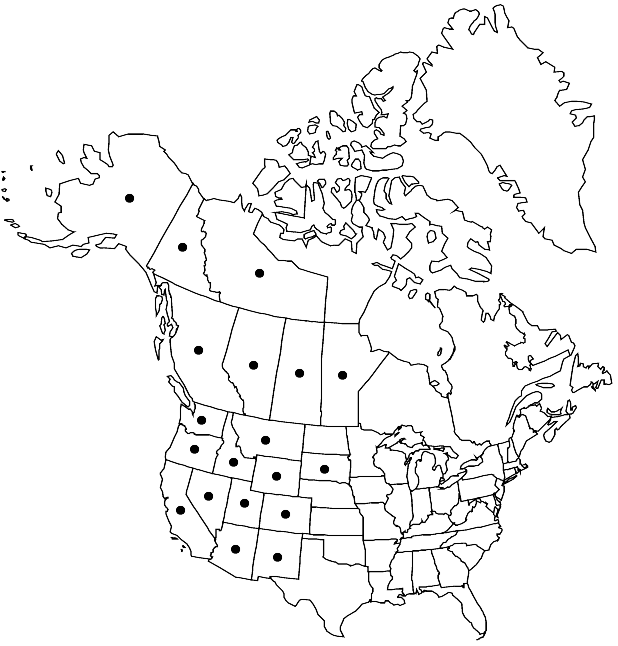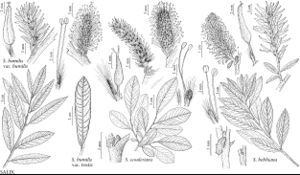Difference between revisions of "Salix scouleriana"
Fl. Bor.-Amer. 2: 145. 1838.
FNA>Volume Importer |
imported>Volume Importer |
||
| (3 intermediate revisions by 2 users not shown) | |||
| Line 8: | Line 8: | ||
}} | }} | ||
|common_names=Scouler’s or mountain willow | |common_names=Scouler’s or mountain willow | ||
| + | |special_status={{Treatment/ID/Special_status | ||
| + | |code=F | ||
| + | |label=Illustrated | ||
| + | }} | ||
|basionyms= | |basionyms= | ||
|synonyms={{Treatment/ID/Synonym | |synonyms={{Treatment/ID/Synonym | ||
|name=Salix scouleriana var. poikila | |name=Salix scouleriana var. poikila | ||
|authority=C. K. Schneider | |authority=C. K. Schneider | ||
| + | |rank=variety | ||
}} | }} | ||
|hierarchy=Salicaceae;Salix;Salix subg. Vetrix;Salix sect. Cinerella;Salix scouleriana | |hierarchy=Salicaceae;Salix;Salix subg. Vetrix;Salix sect. Cinerella;Salix scouleriana | ||
| Line 39: | Line 44: | ||
-->{{#Taxon: | -->{{#Taxon: | ||
name=Salix scouleriana | name=Salix scouleriana | ||
| − | |||
|authority=Barratt ex Hooker | |authority=Barratt ex Hooker | ||
|rank=species | |rank=species | ||
| Line 53: | Line 57: | ||
|publication title=Fl. Bor.-Amer. | |publication title=Fl. Bor.-Amer. | ||
|publication year=1838 | |publication year=1838 | ||
| − | |special status= | + | |special status=Illustrated |
| − | |source xml=https:// | + | |source xml=https://bitbucket.org/aafc-mbb/fna-data-curation/src/2e0870ddd59836b60bcf96646a41e87ea5a5943a/coarse_grained_fna_xml/V7/V7_139.xml |
|genus=Salix | |genus=Salix | ||
|subgenus=Salix subg. Vetrix | |subgenus=Salix subg. Vetrix | ||
Latest revision as of 22:31, 5 November 2020
Shrubs or trees, 1–10(–20) m. Stems: branches gray-brown, yellow-brown, or red-brown, not glaucous, glabrous or tomentose; branchlets yellow-green or yellow-brown, sparsely to densely villous, tomentose, or velvety. Leaves: stipules absent, rudimentary, or foliaceous on early ones, foliaceous on late ones, (1–16 mm), apex acute or acuminate; petiole convex to flat adaxially, 2–13 mm, velvety or villous adaxially; largest medial blade usually oblanceolate, sometimes narrowly elliptic, elliptic or obovate, 29–100 × 9–37 mm, 1.7–3.9 times as long as wide, base cuneate or convex, margins strongly to slightly revolute or flat, entire, remotely serrate, crenate, or sinuate, (glands submarginal or epilaminal), apex acuminate, convex, or rounded, abaxial surface glaucous, sparsely to densely short- to long-silky or woolly, hairs (white, sometimes also ferruginous), wavy or straight, adaxial slightly glossy, pilose or moderately densely short-silky, midrib velutinous or villous, (hairs white, sometimes also ferruginous); proximal blade margins entire, serrulate, or crenulate; juvenile blade reddish or yellowish green, sparsely to densely villous, short- or long-silky abaxially, hairs white, sometimes also ferruginous. Catkins flowering before leaves emerge; staminate stout or subglobose, 18–40.5 × 8–22 mm, flowering branchlet 0–4 mm; pistillate very densely flowered, slender or stout, 18–60(–90 in fruit) × 10–22 mm, flowering branchlet 0–8 mm; floral bract brown, black, or bicolor, 1.5–4.5 mm, apex rounded or acute, abaxially hairy, hairs straight. Staminate flowers: adaxial nectary oblong or square, 0.4–0.9 mm; filaments distinct, glabrous or hairy on proximal 1/2; anthers purple turning yellow, ellipsoid to shortly cylindrical, 0.7–1.2 mm. Pistillate flowers: adaxial nectary oblong or square, 0.2–0.8 mm, shorter than stipe; stipe 0.8–2.3 mm; ovary pyriform or obclavate, densely long-silky, beak slightly bulged below styles; ovules 10–18 per ovary; styles 0.2–0.6 mm; stigmas slenderly cylindrical, 0.4–0.82–1.04 mm. Capsules 4.5–11 mm. 2n = 76.
Phenology: Flowering late Feb-mid Jun.
Habitat: Dry conifer forests, mature woods on edges of streams and lakes, treed bogs, meadows, subalpine slopes, springs, pine barrens, openings in old burns, arroyos and disturbed sites, sandy, silty-clay, or gravelly, igneous substrates
Elevation: 0-3500 m
Distribution

Alta., B.C., Man., N.W.T., Sask., Yukon, Alaska, Ariz., Calif., Colo., Idaho, Mont., Nev., N.Mex., Oreg., S.Dak., Utah, Wash., Wyo., Mexico (Chihuahua, Sonora).
Discussion
Western Salix scouleriana and eastern S. humilis are closely related and are sometimes difficult to separate. Although there is an apparent range disjunction between them in western Manitoba, it may be a collecting gap. In general, S. scouleriana differs from S. humilis in being a taller shrub, sometimes even tree-like, with broader leaves and longer catkins, floral bracts, stigmas, and styles, but these quantitative characteristics all overlap. The apparent difference in anther length (S. scouleriana 0.7–1.2 mm; S. humilis 0.4–0.6 mm) may be correlated with a difference in chromosome number. Salix scouleriana is tetraploid (Y. Suda and G. W. Argus 1968); S. humilis has been reported to be both diploid (Suda and Argus; L. Zsuffa and Y. Raj, unpubl.) and tetraploid (R. D. Dorn 1976). The latter count was from the same population as the one by Suda and Argus. Further chromosome counts are indicated.
See 77. Salix hookeriana for comparative descriptions.
Hybrids:
Salix scouleriana forms natural hybrids with S. hookeriana, S. planifolia, and S. pulchra.
Selected References
None.
